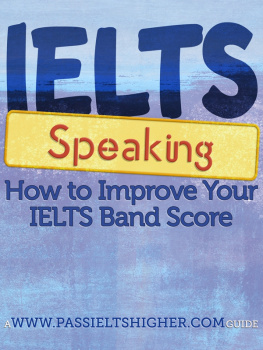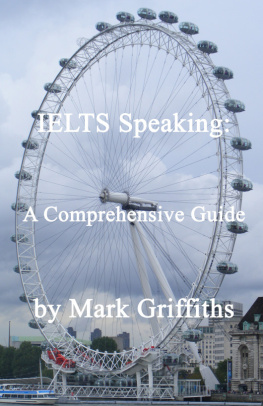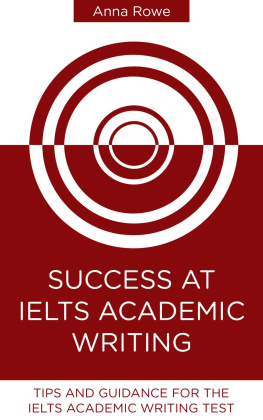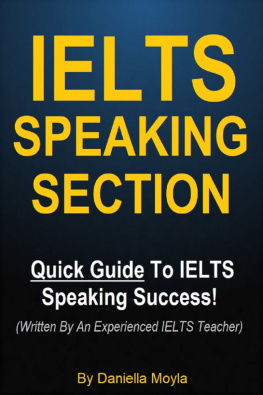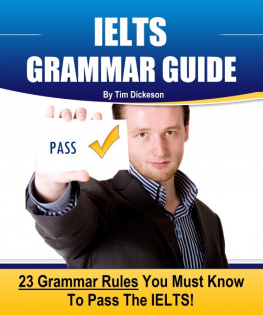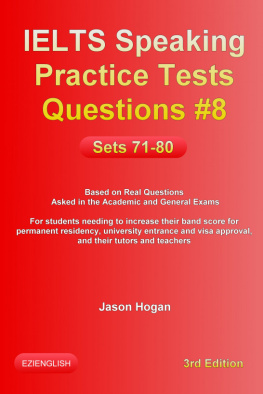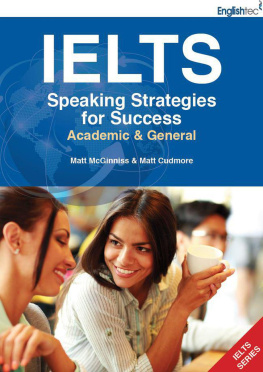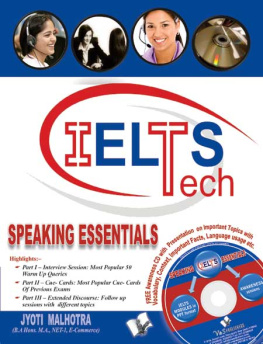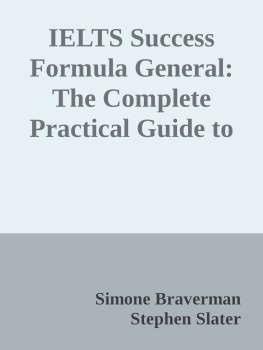Also by Steve Price
How to Improve your IELTS Test bandscores
IELTS Reading: How to improve your IELTS Reading bandscore
IELTS Speaking - How to improve your bandscore
IELTS Writing Task 2: How to Improve Your IELTS Band Score
IELTS Listening: How to improve your IELTS band score
IELTS Task 1 Writing (Academic) Test: How to improve your IELTS band score
Standalone
Proposal Writing - Smart Bids, Tenders and Proposals
Also by Adonis Enricuso
How to Improve your IELTS Test bandscores
IELTS Reading: How to improve your IELTS Reading bandscore
IELTS Speaking - How to improve your bandscore
IELTS Writing Task 2: How to Improve Your IELTS Band Score
IELTS Listening: How to improve your IELTS band score
IELTS Task 1 Writing (Academic) Test: How to improve your IELTS band score
Contents
Copyright 2014, STMP Associates Ltd.
First published in 2014
The Copyright of this document is vested in STMP Associates Ltd., the parent company which owns the Pass IELTS Higher and IELTS Test Prepcast brands, the www.passieltshigher.com website, the www.ieltstestprepcast.com website and related products, and the document is sold only for the purpose for which it is supplied.
All rights reserved. This book or any portion thereof may not be disclosed, reproduced, or used in any manner whatsoever without the express written permission of the publisher.
Publisher:
STMP Associates Ltd.
27, Old Gloucester Street
London, England WC1N 3AX
www.passieltshigher.com
www.ieltstestprepcast.com
The names of companies and website addresses in this book are provided for information of readers with no intention whatsoever to infringe on copyright or trademarks.
All trademarks and registered trademarks appearing in this guide are the property of their respective owners.
The information contained in this book is for information purposes only.
Users of this book are advised to do their own due diligence when it comes to making learning decisions, and all information, products, and services that have been provided or recommended should be independently verified by your own qualified professionals. By reading this book, you agree that the authors and/or the publisher are not responsible for the success or failure of your IELTS Test.
For more information on the IELTS Test, please visit the official website at www.IELTS.org.
About the Authors
As with most books, this book is the work of many people.
Steve Price is creator and owner of Pass IELTS Higher and IELTS Test Prepcast (Businesses and brandsof STMP Associates Ltd.). He is passionate about delivering high-quality information and coaching products to students of IELTS. His vision is to help IELTS candidates to help themselves to higher band scores.
Don Enricuso is a fervent aficionado of the English language. A teacher by heart, he holds an AB English degree and a TESOL certificate (School of TEFL, Canada). Currently, he is pursuing an MA in applied linguistics. He coaches candidates from all over the world in IELTS skills and English proficiency.
Authors Acknowledgments
The authors would like to thank Andrea Price, Fatimah Imam, Jedi Reston, and James England for their practical support and encouragement during the creation and editing of this book.
Front cover design by Jedi Reston
How This Book Helps You
This book gives you, the IELTS Test candidate, detailed guidance on how you can improve your IELTS Speaking Test band score.
The IELTS Speaking Test is no different from any other exam or test type. There are techniques, which can be practised and which will place candidates in a better position to answer each given question type.
The main chapters in this book teach you those techniques for the IELTS Speaking Test .
Before we get to the techniques which can help you improve your band score, we set the scene by explaining more about IELTS band scores, by reference to the IELTS General Descriptors. We also provide some general advice for the IELTS Speaking Test and explain the structure of the IELTS Speaking Test.
Understanding Band Scores
Each of the three tasks is rated against four criteria: fluency and coherence, lexical resource, grammatical range and accuracy, and pronunciation.
Scores range from 09; a 0.5 band is also possible, which makes a big difference (contrary to how it looks).
In improving band scores, constant testing, which Cambridge tests provide, will not be sufficient. After establishing your IELTS level, you then need to progress to building up the skills necessary and addressing identified weaknesses.
Realistically, this can only be achieved through continuous immersion in English.
The following table provides a high level description of the English language competences associated with each band score level. These are called the General Descriptors for IELTS Speaking.
General descriptors for IELTS band scores 0-9

The IELTS Speaking Test - General Advice
This section of the book provides a description of the IELTS Speaking Test. You should take time to learn what the speaking test entails as it will help you to structure your preparation.
The speaking test is divided into three sections and lasts from eleven to fourteen minutes. Candidates are being tested on; fluency and ability to express themselves in English, how complex grammar is used, and pronunciation. But fluency is especially important.
You need to be aware you are being assessed from the minute you walk into the exam room, so should always try to use your most complex expressions in English and complex grammar to impress the examiner. As mentioned above, fluency is very important, so try not to hesitate when speaking or try not to think too much about the accuracy of your answers. This will make you sound less fluent and lose you valuable marks.
For the fluency point, students often ask if is it advisable to learn an opening by rote so that they can come in fully prepared, being able to talk about where they come from or what university they go to, or whatever. The answer to this question is a resounding NO. If the examiner realises that youve prepared something youre speaking about, you actually get zero, so it doesnt really help you .
A better approach would be to learn expressions and drop them naturally into your speaking.
The IELTS Speaking Test - Structure
This section of the book provides a description of the structure of the IELTS Speaking Test. You should take time to learn what the speaking test entails as it will help you to structure your preparation.
IELTS Speaking Test Part 1 is an introductory interview on the candidates personal background or other aspects which will be familiar to the candidate. Topics could include: family, hometown, and hobbies, among others. This part lasts for four or five minutes.
IELTS Speaking Test Part 2 is a two-minute monologue by the candidate; the task is to describe any familiar person, object, place, event, or idea - sometimes, for a period of two minutes.
IELTS Speaking Test Part 3 is a follow-up to the monologue. The candidate is asked to answer more abstract and complex questions that are related to the topic given in the previous task. Like part 1, part 3 lasts for four or five minutes.
Some of the topics include; traditional versus modern family, technology and its pros and cons, advertising and its attributes, animal rights, education, modernisation, climate change, aging societies, consumerism, morality, work, and success and failure.

